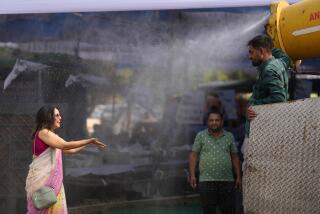Mobilization to Lower Disaster Tolls Urged : Catastrophes: A team of experts informs the United Nations that preventive measures will require more emphasis in the 1990s.
- Share via
UNITED NATIONS — An estimated 1 million people have died in the past 20 years from earthquakes, 2 million more have died in other natural hazards and 1 billion have been permanently injured or left homeless by catastrophes--losses that could have been substantially reduced by preventive planning.
This was the conclusion of a group of experts convened to draft programs for the 1990s, which have been designated by the U.N. General Assembly as the International Decade for Natural Disaster Reduction. The experts’ report was made public today.
The group, headed by Frank Press, U.S. geophysicist and chairman of the National Academy of Sciences, called for the mobilizing of the “full force of scientific and technological advancement to reduce the human tragedy and economic loss from natural disasters.”
The report praised the emergency relief that has customarily flowed to victims of catastrophe but criticized such efforts for concentrating on the immediate damage and failing to “reduce the vulnerability of human societies.”
To do this, the experts said, will require better data gathering, improved forecasting and warning technology, improved preparedness techniques (only Japan was cited for adequate planning) and changed public attitudes. Too often, the report said, public apathy and poverty contribute to fatalistic acceptance of the forces of nature.
“In recent times, the majority of fatalities and the most damaging economic losses have been borne by the developing countries, and in the least developed and most highly populated regions the number of fatalities from natural hazards appears to be increasing,” the report said, adding that beyond human costs “the effects on the economy and the development of these regions are increasingly grave.” The combination of direct losses and reconstruction costs “often represent a significant part of the gross national product.”
Industrialized countries generally have better warning systems and more resources to recover from the effects of natural disasters, but the experts said both rich and poor nations show “reluctance to spend money to prevent disasters.” They said this attitude changes in the immediate aftermath of a catastrophe, however.
While weather forecasting has improved greatly in recent years, the report said that prediction of geological hazards has made little progress and that “short-term earthquake prediction will probably not be achievable in the (1990s) despite ongoing research.”
Quake-resistant building design has advanced greatly in new construction, but the strengthening or replacement of existing vulnerable buildings in areas at risk will require “focused attention during the decade.”
In addition to stricter building codes, the report recommended “microzonation”--mapping of subsoil characteristics to identify unsafe building sites. Such mapping might have reduced the damage from the 1985 Mexico City earthquake, in which a pattern of high vulnerability appeared.
While the experts observed that the entire Pacific Basin is exposed to heavy earthquake and storm damage, they singled out South and East Asia as the region suffering most from natural hazards.
An average of 25 typhoons a year strike Vietnam, the Philippines, China, Korea and Japan, and less frequent tropical cyclones sweep across the Indian subcontinent, creating devastating floods in Bangladesh and India. Magnifying the effect of natural disasters in the region are overpopulation and the concentration of investment in the most congested areas.
More to Read
Sign up for Essential California
The most important California stories and recommendations in your inbox every morning.
You may occasionally receive promotional content from the Los Angeles Times.












